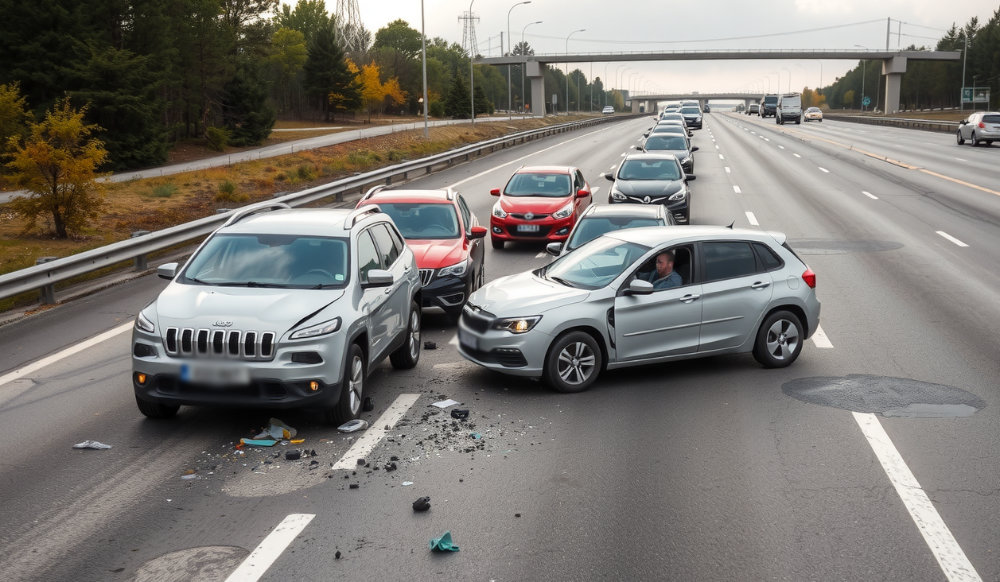
In legal terms, fault refers to responsibility for an act or omission that causes harm. When more than one vehicle is involved, the damage often multiplies. Those involved want to know how the accident started.
At Hauptman, O’Brien, Wolf & Lathrop, LLC, we provide accident victims and their families with the answers and solutions they deserve. Our personal injury lawyers realize that determining fault and establishing liability are essential components of successful lawsuits. If you want to recover compensation for your losses, we can help you pursue justice.
Your recovery is our priority. We can explain your rights during a free consultation, giving you unparalleled peace of mind. Schedule your strategy session by calling (402) 241-5020 or completing the contact form so that our Nebraska or Iowa personal injury attorneys can get back to you.
How to Determine Fault in a Multi-Vehicle Crash
In a multiple-car collision, more than one party might have contributed to the series of events. Determining fault is complex, but your professional legal counsel can help pinpoint the responsible parties. Consider following the steps described below with your lawyer as soon as possible.
Request an accident report at the scene
You must report accidents causing injury, death, or property damage exceeding state-established monetary limits. Call 911 for emergencies or the local dispatch line to reach law enforcement officers.
The accident report officers prepare should contain objective details, such as those listed below, that could prove invaluable for your case later:
- Date, time, and location of the event
- The other drivers’ information (contact details, insurance policy numbers, vehicle descriptions, license plate numbers, and number of passengers in each car)
- Description of property damage, including fences, telephone poles, and livestock
- Description of injuries to the reporting party and other involved parties
- Names and accounts of witnesses
- Weather and road conditions at the time of the crash
Though this report is helpful, it does not replace your own documentation. Take plenty of photos and videos of the scene, vehicle damage, and your injuries. Write down as much as you can remember about what led up to the crash while your memory is fresh.
Hire experienced accident lawyers to investigate
A multiple-vehicle pile-up occurs when several cars collide with each other in quick succession, creating a chaotic scene on the road. For example, suppose one car suddenly brakes to avoid an obstacle. What happens if the vehicles behind it don’t have enough time to stop?
The first impact can push cars into one another, leading to a series of crashes. However, once there is a tangled mess of metal and debris, it is difficult to determine the initial event that set off the chain of collisions.
Some examples of multi-car accidents are:
- Head-on crash: The front ends of 2 or more vehicles traveling in opposite directions collide
- Side-impact crash (T-bone): The front of one vehicle strikes the side of another, often at intersections
- Sideswipe crash: Motor vehicles traveling in the same direction make contact along their sides, often during lane changes
- Rear-end crash: A vehicle crashes into the back of another vehicle, commonly due to sudden stops, slick roads, or following too closely
- Pile-up (multi-vehicle) collision: Multiple collisions, sometimes crushed or stacked together, typically occurring on high-speed roads during poor weather or low-visibility conditions
Personal injury lawyers have the expertise and resources to determine what caused the first crash and who is responsible. Negligent behavior often plays a role.
Get help to assess negligence
Negligence refers to the lack of reasonable care by someone who had the duty to exercise it. For instance, a reasonable driver should always prioritize safety and be aware of their surroundings.
A motorist might fail this duty if he or she demonstrates risky behaviors, such as:
- Disobeying traffic laws like speed limits and traffic signals
- Failing to indicate lane changes or turns
- Following others too closely, especially in adverse weather conditions like rain or fog
- Allowing distractions to take the focus from the driving task
- Operating a vehicle under the influence of drugs or alcohol
- Driving while drowsy or fatigued
Identify the liable party or parties
In multi-car accidents, liability can be complex. An experienced personal injury lawyer has what it takes to dig deep, identify the responsible people or companies involved, and pursue compensation from them on your behalf.
Besides the drivers, other potentially liable parties in a multi-car accident may include:
- Vehicle manufacturers, if a mechanical defect caused or worsened the crash
- Government agencies responsible for unsafe road design or poor maintenance
- Employers, if a commercial vehicle was involved during work-related duties, especially if irregular inspections or poor maintenance practices contributed to mechanical failure
- Auto repair shops, if faulty repairs or maintenance contributed to the accident
Consider the legal principles involved
Did the multiple-car collision occur due to someone’s negligence? Here are 3 main principles that could affect your case:
- Contributory negligence is a legal doctrine that prevents a plaintiff from recovering damages if he or she shares any responsibility for the accident
- Pure comparative negligence allows a plaintiff to recover damages even when up to 99 percent at fault, with compensation reduced by percentage of fault
- Modified comparative negligence permits a plaintiff to recover damages if his or her fault is below a certain threshold, typically 50 or 51 percent, meaning recovery is impossible when equally or more at fault than the other party
The negligence rules that could apply to your claim vary by state. For instance, if you crash in Nebraska, modified comparative negligence rules would allow you to recover damages as long as you were less than 50 percent at fault. On the other hand, if you had the same crash in North Carolina, you could not receive damages if you were even 1 percent at fault.
Of course, there are exceptions to most rules. The best way to understand the role of negligence in your case is to consult a local personal injury lawyer. He or she can determine your eligibility for compensation.
How to Establish a Strong Personal Injury Case
Proving who was at fault is only part of the process. To turn that into compensation, you also need clear evidence that shows how the accident affected you and why the other party should pay. The attorneys of Hauptman, O’Brien, Wolf & Lathrop, LLC can help you build a strong claim with elements similar to those discussed in the following section.
Act fast
Time is not on your side after a car crash. Each state has a statute of limitations. These legal deadlines dictate how long you have to start legal proceedings for compensation.
If you wait too long, you may lose the right to recover compensation. But if you secure legal counsel early, your legal team can act promptly to file your accident claim.
Gather evidence
Case-winning proof is often hard to find, and it can disappear quickly. For example, physical evidence may be lost, video surveillance is routinely deleted, and witnesses may be difficult to contact. Prompt action also gives your lawyers the best chance to preserve key evidence.
Working with a personal injury team can also aid your recovery during the investigation stage. While you focus on your health, your lawyer and support staff can handle the time-consuming work of collecting and organizing proof for your claim.
Potential evidence and documentation may include:
- Medical records that describe your injuries
- Medical bills related to your course of treatment (e.g., costs of hospital stays and doctor’s consultations, transportation to and from appointments, prescription drugs)
- Copies of police reports
- Witness statements
- Proof of lost income
- Repair estimates or records of property damage
- Communications with insurance companies
- Photographs and videos
Each of these pieces helps tell the full story of what happened and how the accident has affected your life. Yet, requesting records, following up with insurance providers, and documenting losses takes time and effort. Our firm takes care of these steps for you so you can avoid added stress.
Reconstruct the event
In multi-vehicle accidents, it is not always clear who is at fault. When the facts are disputed or unclear, a personal injury team may bring in an accident reconstructionist. These trained professionals study the crash scene, damage patterns, road conditions, and witness accounts to recreate the accident as closely as possible.
Accident reconstructionists use scientific methods, sophisticated tools like computer simulations, and forensic analysis. Their findings can be used in negotiations or in court to show who most likely caused the crash. An attorney can determine whether accident reconstruction is necessary for your case and secure respected opinions that remove doubt and confusion.
With so much on the line, prompt investigation, expert reconstruction, detailed reports, and testimony can strengthen your claim. Taking these steps can make a big difference in the take-home amount of your settlement.
Learn How to Recover Maximum Compensation
The at-fault driver is responsible for the cost of the accident, including damage to vehicles, medical bills, and lost wages. In multiple-vehicle crashes, blame might fall on more than one party. Yet, getting the money you are due is not automatic.
Insurance companies try to pay as little as possible to protect their profits. The liable party might deny accountability. At Hauptman, O’Brien, Wolf & Lathrop, LLC, our car accident attorneys understand the challenges and have the knowledge and resources to overcome them.
Why not get trusted advice if you were hurt in a multi-vehicle accident? Schedule a free case review today to learn how to protect your financial best interests. Your future is at stake, so don’t delay in calling us at (402) 241-5020.


Very friendly, very helpful, very educated and got me what I deserved.Thank you ..